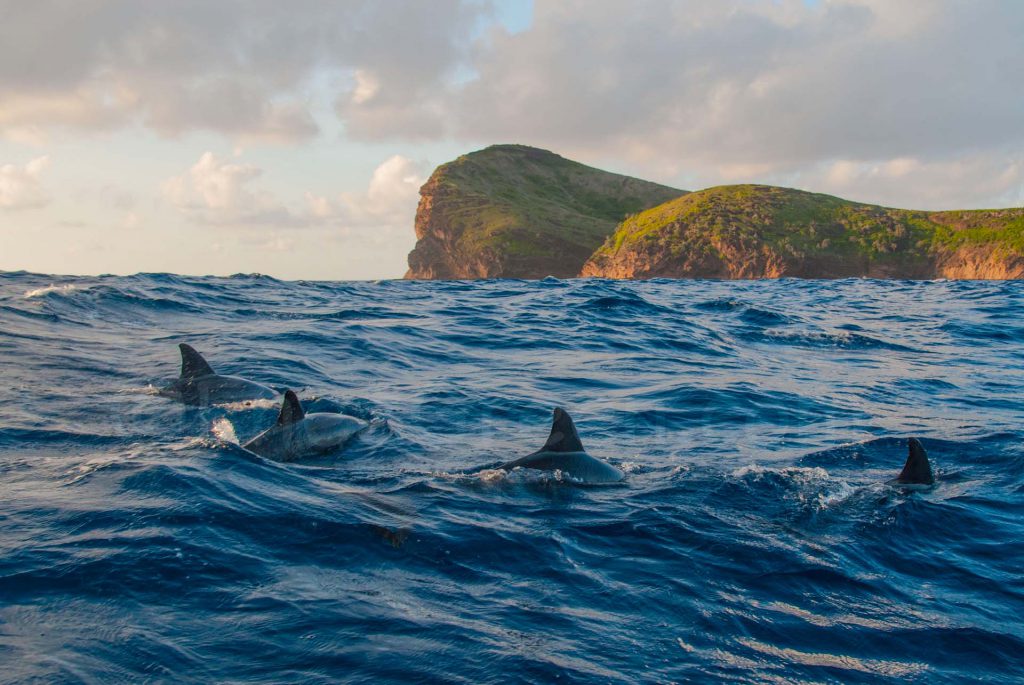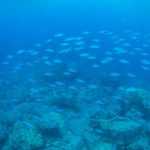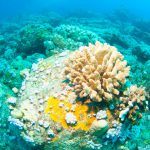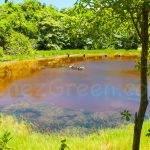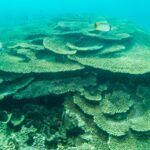Owing to its tropical climate, Mauritius enjoys temperatures of 25 °C to 35 °C during the hot season, between January and April. During the cool season, from July to September, average temperatures vary between 22 °C and 24 °C. The rainy season lasts from November/December to April, with occasional tropical rain showers. The sea temperature generally remains above 22 °C.
Protecting the coastline and the marine environment
The national network of Marine Protected Areas was created in 1999, in line with the first National Environment Action Plan. It comprises 2 national parks and 6 fishing reserves managed by the Albion Fisheries Research Centre – a national agency operating under the aegis of the Ministry of Agriculture and Fishing. The second National Environment Action Plan set ambitious targets for the 2000–2009 period, but these objectives are yet to materialize. Relevant laws are not being fully enforced, and there is a blatant absence of monitoring.
Various NGOs are actively working with the Government for the conservation of marine resources, namely the Mauritian Wildlife Foundation (MWF) on Round Island and Ile aux Aigrettes, the Mauritius Marine Conservation Society (MMCS) and Shoals of Rodrigues (a protected marine area has been created in Rodrigues Island in the context of a United Nations Development Programme-Global Environment Facility, UNDP GEF project).
Founded in 1984, The Mauritian Wildlife Foundation is doing remarkable work for the preservation of endangered birds, plant, reptile and mammal species. This NGO strongly supports the creation of national parks and has joined in the fight against deforestation and intensive sugarcane cultivation, which has already caused much damage. Out of the 12,000 ha of existing forests, only mountainous reserves still harbour the 3% of primitive forests.
Moreover, the MWF is renowned for its programmes to reintroduce and preserve the endemic vegetation, the most probing one being the restoration of Ile aux Aigrettes. Over the past 25 years, the MWF team has worked relentlessly to weed out invasive plants and rid the island of invasive animals, replacing them with endemic species. The biodiversity of Ile aux Aigrettes is now close to what existed 400 years back, with over 60 indigenous plants. The outcome is positive, particularly regarding the reintroduction of endemic species such as the Pink Pigeon, whose population has grown from 9 specimens in 1990 to 54 actually on Ile aux Aigrettes and 380 all over the country.
The Mauritius Marine Conservation Society has been striving for over 25 years to educate and sensitize the Mauritian population on the need to protect the marine environment, mainly sea mammals and coral reefs. This NGO conducts various programmes for the safeguard of marine ecosystems, namely through the creation of artificial reefs using old and disused vessels, the identification of protected marine areas, the installation of permanent mooring buoys for reef users. It also highlights the value of undersea archeological sites and works towards the eradication of blast and harpoon fishing. Furthermore, the MMCS establishes inventories and undertakes the scientific monitoring of sea mammals. The flagship project of the MMCS in recent years relates to the management of dolphin watching activities on the West Coast. The NGO designed a programme to raise awareness among the public and train boat skippers. A charter has also been drafted for a responsible approach of the dolphins in the bay.
‘Maurice Ile Durable’: Political will for a sustainable island
According to a 1997 Intergovernmental Panel on Climate Changes (IPCC) report, Mauritius ranks first among countries threatened by climate changes. This is a major concern for the country, and sustainable development has become an imperative. The ‘Maurice Ile Durable’ (Mauritius, a Sustainable Island) initiative was launched in 2008 and has set as a target to provide for 65% of the country’s energy needs from local renewable energy sources by 2025, namely by using ‘bagasse’, a by-product of the sugar industry. A year and a half later, a Maurice Ile Durable (MID) Fund has already been created to support the efforts to protect the environment.
Energy mix
Joel de Rosnay, a French scientist of Mauritian origin, is a special advisor to the Prime Minister on this issue. He recommends that by 2028, the country’s energy mix should be: 35% biomass energy (bagasse, bio-ethanol, biogas), 15% thermal and photovoltaic solar energy, 6% eolian energy, 3% hydroelectric energy, 3% cogeneration and geothermal power, 3% from various energy sources including wave energy, 20% clean coal energy and 15% fuel oil power.
Solar energy
Nearly 4,600 families have benefited from individual Government grants of Rs 10,000 (€ 250), representing a total sum of Rs 58 million (€ 1.5 million) for the purchase of solar water heaters.
Eolian energy
Rodrigues Island has a small energy production unit with three turbines since 2003. Other projects are under way in Mauritius, namely a windmill farm by a major sugar estate (Omnicane Ltd), which is also the island’s most important private energy producer. This ambitious project requires an investment of around € 49 million for the installation of 22 windmills with a capacity of 1 MW each among sugarcane plantations in the south of the island. The production capacity will be equivalent to the energy needs of 75,000 inhabitants, i.e. 6% of the Mauritian population, this initiative will reduce yearly CO2 emissions by 44,000 tons.
Energy saving
The Government has financed the installation of over a million energy-saving light bulbs.
The road, school, hospital and public lighting systems will also be optimized. Moreover, customs duties have been reduced by half in July 2008 to encourage the use of less polluting (hybrid) cars such as the Toyota Prius. Khalil Elahee, a researcher and lecturer at the University of Mauritius, has worked on the MID concept. He considers that the implementation of a new mass transport system is a top priority, the actual bus system being inadequate.
Wastewater treatment
A quarter of the population is actually connected to the public sewage network. The Government has embarked on the privatisation of the sector to address this priority sanitary issue, which is crucial for the preservation of the quality of swimming water, and hence of tourism. More than ten sponsoring agencies have agreed to provide up to € 360 million financing for seven priority wastewater treatment projects in the country. A third of that sum will be devoted to the construction of an important water treatment plant.
Sustainable tourism
Hotels with more than 75 rooms are also bound by regulation to have their own water treatment stations. Even if the enforcement is not strictly controlled, most hotels comply with the regulation, having understood the usefulness of recycling waste water to irrigate golf courses and gardens. Some hotels have developed a natural concept, using plants in a retention pond for the biological treatment of sewage. Furthermore, certain Mauritian hotel groups like Beachcomber Hotels and Naïade Resorts have invested in sea water desalination stations to address the water shortage problem.
Construction
Residents and promoters of newly constructed residential and hotel complexes are bound by the Government to apply sustainable development criteria and to replace any tree that is cut down or used. The legislation also requires the preservation of indigenous species and of the biodiversity.
School of Tourism and Sustainable Development
Since 2009, the University of Technology, Mauritius (UTM) offers courses with a sustainable development component such as MSc courses in Sustainable Environmental Management and in Corporate Governance and Corporate Social Responsibility, as well as a BSc (Hons) course in Sustainable Environmental Planning and Management targeting architects and engineers. The School of Tourism and Sustainable Development already counts over 400 students.
Reasons to hope
Since July 2009, the Government requires major business concerns to devote at least 2% of their profits to corporate social responsibility. Pamela Bapoo-Dundoo is the national coordinator for the UNDP GEF Small Grants Programme. According to her, € 18 to 22 million should thus be generated and distributed to NGOs and other registered associations – the country counts some 8,000 NGOs! A significant amount of money which is not always used most efficiently. ‘Corporate social responsibility initiatives should be coordinated. Instead of financing projects on an individual basis, businesses should consider financing collectively a project at national level,’ says Pamela Bapoo-Dundoo. The UNDP GEF Small Grants Programme was launched in 1995 to support local initiatives in relation with global environmental issues through community action. The UNDP provides financing up to US$ 50,000 to NGOs and other associations to support micro projects in the field. In 2009 only, 114 projects have been financed for a total amount of US$ 3 million, besides US$ 6 million devoted to co-financing aid and a contribution ‘in kind’ estimated at US$ 5 million.
Nautical events in Mauritius
The Mauritian Route: From Port Louis to Port Louis
French navigator Francis Joyon has inaugurated a new maritime route between a port in Brittany and Mauritius in October 2009. The actual solitary round-the-world record holder is following in the steps of great navigators who embarked on the Road to the Indies in olden days. Aboard his maxi trimaran ‘IDEC’, the skipper from the Morbihan region has set the reference time by covering the 10,000 miles (18,500 km) between Port Louis in Morbihan and Port Louis in Mauritius in 26 days 4 hours 13 minutes and 29 seconds at an average speed of 16.4 knots (30.3 km/h). The World Sailing Speed Record Council (WSSRC) has ratified the record due to its sporting and historical interest and the event now features in the list of 20 races counting for the Ocean Records World Championship. ‘This interesting journey is the equivalent of three races across the Atlantic and is as intense as a round-the-world race. After sailing down the Atlantic Ocean, you cross the Cape of Good Hope and then sail upwards to reach Mauritius’, says Francis Joyon.
La Regatta
The Bay of Mahebourg, a historical region where the Dutch landed in 1598 and the famous Battle of Grand Port took place, is the décor for La Regatta, a traditional pirogue race held every year.
This competition is open to all companies and individuals eager to discover this Creole tradition. La Regatta is an eco-responsible event whose main objective is to promote and share authentic Mauritian values with the general public. Various associations that are actively engaged in the protection of the environment have joined in to help preserve the lagoon and emphasize environmental education.
The boats are all authentic regatta pirogues – with sails specially made for the event and complying strictly with required dimensions. The traditional pirogues used by the fishermen are made of meranti and black wood. The mast is made of ‘Takamaka’, a pantropical tree that reaches up to 30 metres high whereas the topsail is generally set on a bamboo stem.
Round Mauritius race in inhabitable sailboats
The Grand Bay Yacht and the Mauritius Sailing Federation also hold a three-day Round Mauritius race in inhabitable sailboats. The regatta is open to inhabitable monohull or multihull sailboats, which can take part in the race or simply accompany participants. After departing from Grand Bay, the boats sail down to Mahebourg, then to Black River before sailing back to the starting point.
The Yemaya Kayak Tour
This four-stage annual ecological tourism and sports event consists in a tour of the island in four days. Each stage is 25 km-long, from Black River to Bel Ombre, from Pointe d’Esny to Ile aux Cerfs, from Roches Noires to Grand Bay and back to Port Louis.
This event aims at enabling participants to discover the beauty and diversity of the Mauritian coastline as well as to develop a passion for the sea by learning to respect and protect it.
The fourth edition will take place during the Easter holidays from 5 to 8 April 2010. The receipts from the event will partly be donated to the Forever Blue Association to support its project to preserve the biodiversity of Ile d’Ambre.
The Kiteival
The Kiteival is the only kitesurf festival in Mauritius.
This event is held over a number of stages around the island and is open to kitesurfers of all levels. The first edition was a success with the participation of 37 ‘pioneer’, professional and amateur local and international kitesurfers.
The economy and sustainable development
Tourism
Tourism stands out as a vital sector of the Mauritian economy with nearly 900,000 visitors each year. It provides employment for more than 16% of the working population and contributes to nearly 10% of the country’s GDP. The Integrated Resort Scheme (IRS), a specific land development scheme, was launched seven years ago. Foreign investors benefit from a residential permit and an appropriate tax regime as an incentive to boost the sales of these luxury residences. This sector has generated over Rs 15 billion (approx € 375 million) in terms of foreign direct investment since its inception.
Mauritius is now renowned as a highly popular tourist destination but the socio-economic changes that occurred over the past few decades have had a disastrous ecological impact on its ecological heritage. The island has long lacked proper drainage networks, sewage systems or even household garbage collection systems. Pollution and cyclones (which are increasing in intensity and frequency in the region) have had disastrous effects on the lagoon and on the coral reefs, with sediments from the inland running into the lagoon. Sustainable development is the only option to restore and preserve the natural heritage of the island, and thus continue to attract high-end tourism. Environmental awareness is on the rise among the population, and tourist operators as well as other industries are showing an increased commitment to improve the situation. The national airline, Air Mauritius, has signed an agreement with the Mauritian Wildlife Foundation to plant a number of trees equivalent to its total number of plane take-offs. More than 6,000 trees are planted on the island every year through this initiative.
Ecological tourism is a gradually emerging sector with the launch of new activities to foster the discovery of the island’s rich fauna and flora.
Agriculture and energy
Mauritius presently produces nearly 70% of its electricity needs from imported crude oil. According to Khalil Elahee, a Mauritian academic and specialist in energy, Mauritius has an enormous potential to reduce its dependence on fossil fuels. ‘The country already produces more than 16% of its electricity from biomass (bagasse) as well as 30 million litres of ethanol. The whole production of ethanol is unfortunately exported while it could be used locally to produce E10, a mix of dehydrated ethanol (10%) and gasoline (90%), to run engines without having to modify them.’ Khalil Elahee, who is a researcher and lecturer at the University of Mauritius, considers that the MID project rests on energy saving and the emergence of small independent renewable energy producers. The sugar industry is the energy producer of tomorrow. ‘Indeed, the gradual phasing out of the Sugar Protocol encourages the traditional sugar industry to turn towards the generation of high value added through the production of refined sugar and ethanol and the increasing use of bagasse to produce energy.’ Consequently, appropriate legislation should be introduced to set up the required public infrastructure and set the selling price per kilowatt-hour to the Central Electricity Board, the national electricity utility of Mauritius.
The fishing industry
The country counts between 2,000 and 2,500 artisanal fishermen according to different sources for annual catches of 950 tons in Mauritius and 1,500 tonnes in Rodrigues. Eighteen fish aggregating devices have been set up to reduce the pressure on coastal resources. A bad weather allowance is also paid to fishermen and this financial compensation helps to relieve the pressure on the marine resources.
Maritime history
Mauritius is above all a mythical stopover for renowned navigators such as Bartholomeu Dias, Vasco da Gama and Robert Surcouf on the former Road to the Indies. The island’s economy has developed around maritime trade during successive Dutch, French and British colonisation periods.
After the conquest of India, the Arabs laid out the first commercial settlements in the Mascarene Islands between the 8th and 16th centuries. Mauritius was then named ‘Dina Arobi’ and is said to have served as a refuge for Arab pirates, who buried their treasures on the island. From the beginning of the 16th century, the Portuguese undertook to conquer Arab trading posts in the Indian Ocean. Just like the Arabs, the Portuguese didn’t consider the island to be of great interest and only used it as a port of call.
During a storm in 1598, a flotilla of the Dutch East India Company took shelter in a bay in the southern part of the island. Grand Port was then created and the first name of the Prince of Nassau, Mauritius, was given to the island. The Dutch settlers left the island in 1710 after having had their share of bad weather and epidemics.
The French took possession of the island a few years later and renamed it ‘Isle de France’. The development of the island sprung up under French Governor Bertrand Francois Mahé de La Bourdonnais, whose origins were in Saint Malo, France. He turned Isle de France into a strategic stronghold in the Indian Ocean. During that period, the sugar industry underwent rapid development and Port Louis became a free trade port and a shelter for corsairs, among whom the famous Robert Surcouf. The British launched attacks on the corsairs and on the island as from 1810. They were initially defeated in August 1810 during the Battle of Grand Port, which was Napoleon’s only naval victory over the British. In 2010, Mauritius has celebrated its rich maritime heritage, particularly the bicentenary of this famous battle. However, the British didn’t give up and landed on the northern coast, at Cap Malheureux, in December 1810. After taking over the island, they changed its name back to ‘Mauritius’. The British guaranteed the maintenance of the language, religion and legal system (Code Napoleon) of the inhabitants of French origin, and the latter maintained ownership of their sugar plantations. This explains why Mauritius is presently a bilingual country.

